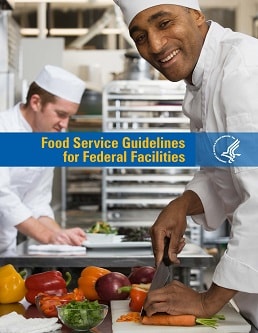Food Service Guidelines for Federal Facilities: A Model for Your State or Community
One of the most comprehensive sets of food service guidelines available is the Food Service Guidelines for Federal Facilities [PDF-3.34MB]. Written to improve access to healthier foods and beverages at federal facilities, this model set of guidelines can be readily used in public and private settings within your state or community.
The Food Service Guidelines for Federal Facilities is a set of voluntary best business practices to increase healthy and safe food options for employees and visitors. When the Food Service Guidelines for Federal Facilities are written into contracts, they become organizational policy.
What are the goals of the Food Service Guidelines for Federal Facilities?
The standards in the Food Service Guidelines for Federal Facilities are designed to ensure that:
- Healthier foods and beverages are available and encouraged.
- Environmentally responsible practices are practiced in food service venues and communities are economically supported through local food sourcing.
- Food safety practices are followed to minimize the risk of foodborne illnesses.
More than 60 scientists and food service operators from nine federal agencies and departments collaborated to develop the Food Service Guidelines for Federal Facilities.
Where can the Food Service Guidelines for Federal Facilities be used?
The Food Service Guidelines for Federal Facilities is not limited to federal facilities. Use the Food Service Guidelines in settings such as hospitals and healthcare facilities, colleges and universities, parks, private worksites, and state and local agencies. Within these settings, the guidelines can be used in all food service venues such as cafeterias and cafes, grills, snack bars, concession stands, micro markets, and vending machines.
Food service guidelines can be adapted for use in settings where food is served or distributed, such as correctional institutions, eldercare facilities, faith-based organizations, and food banks or pantries.
What are the potential benefits of the Food Service Guidelines for Federal Facilities?
- Improves accessibility of healthier foods and beverages. The food and nutrition standards recommend that specific healthier foods and beverages be available for purchase. In alignment with the most current Dietary Guidelines for Americans, the Food Service Guidelines for Federal Facilities include food and nutrition standards that support offering a variety of fruit and vegetable options (including seasonal); whole grain-rich products; plant-based proteins; lean protein entrees; lower sodium meals, entrees, and sides; freely available drinking water; and more.
- Helps people choose healthier foods. Standards for using behavioral design practices are included to facilitate the selection of healthier foods. Selection of healthier foods and beverages is influenced by how products are prepared, placed, presented, promoted, and priced. The behavioral design standards suggested in the Food Service Guidelines for Federal Facilities were developed with these influences in mind.
- Improves facility efficiency. The Food Service Guidelines for Federal Facilities contains standards for instituting accurate forecasting practices; purchasing bulk-serve condiments; promoting the use of reusable plates, utensils, and beverage containers; and more.
- Supports the environment. The Food Service Guidelines for Federal Facilities supports environmentally beneficial practices such as:
- Using compostable and bio-based trays, flatware, plates, and bowls when offered.
- Using cleaning products and services that are environmentally preferable.
- Purchasing seafood from responsibly managed, sustainable, and healthy fisheries.
- Using energy and water saving equipment.
- Using integrated pest management practices, green pest control alternatives, and routine cleaning.
- Participating in recycling, composting, and other waste diversion practices.
- Supports local economies. The Food Service Guidelines for Federal Facilities supports community development by recommending that a specific percentage of foods and beverages offered should be “locally sourced, certified organic, produced with another certified community-development or environmentally beneficial practice, or any combination thereof.”
- Lowers risk of foodborne illness. The Food Service Guidelines for Federal Facilities reminds food service operators to follow the Food and Drug Administration’s Food Code to prevent foodborne illness. It also suggests evidence-based best practices (such as managerial practices, employee behaviors, and food preparation practices) that go beyond what is described in the Food Code and that, when implemented, may further reduce the risk of foodborne illness.
Resources
The Food Service Guidelines for Federal Facilities [PDF-3.34MB] is a set of voluntary best practices that can be used to increase healthy and safe food options for employees and to ensure that environmentally responsible practices are conducted.
An Ancillary Report of the Food Service Guidelines for Federal Facilities [PDF-1.15MB] provides the methodology for how the Food Service Guidelines for Federal Facilities was developed and provides rationales for each of the standards.
Food Service Guidelines: Easy Access to Healthy Food is a two-page infographic that explains food service guidelines. Share the link or download the PDF to show decision-makers in your community or institution.
USDA’s Food Loss and Waste, FDA’s Food Loss and Waste, and EPA’s Sustainable Management of Food websites provide information on reducing food waste.
